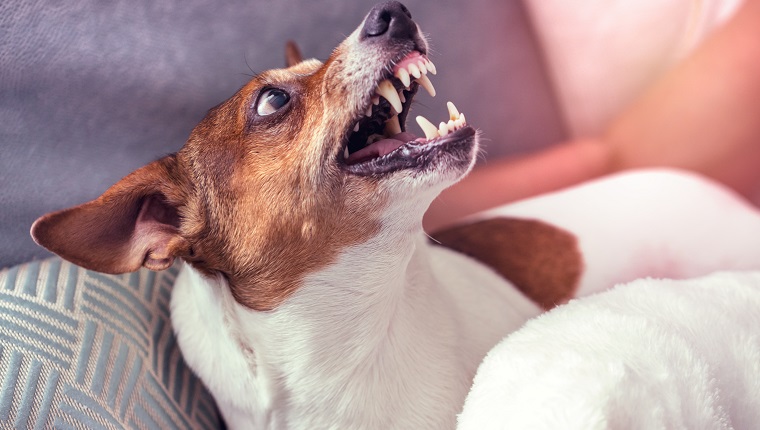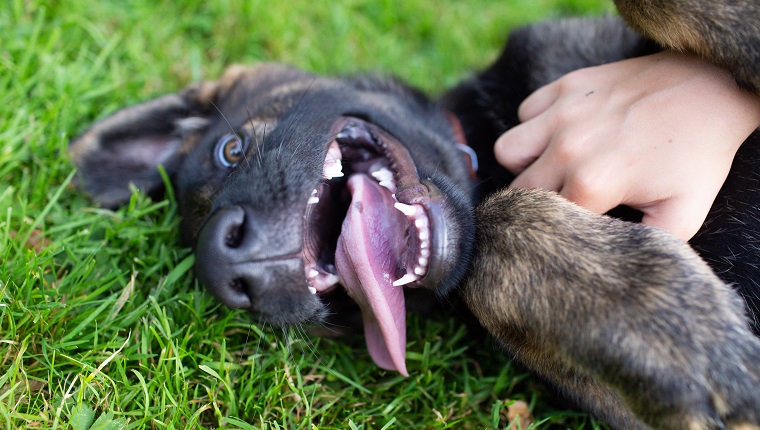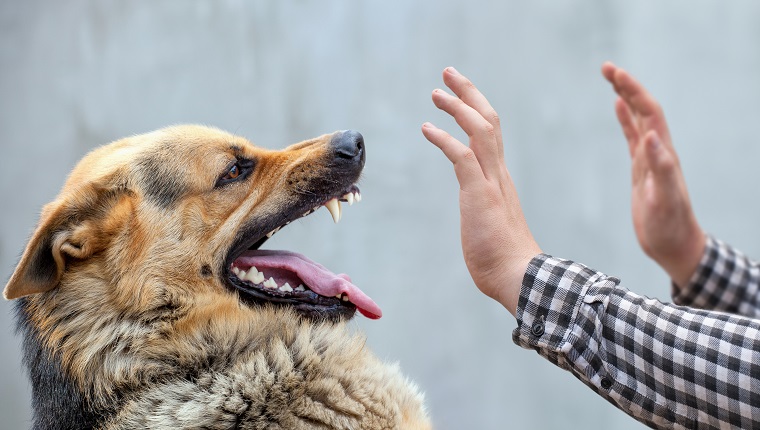There are many types of aggression in dogs, but perhaps none are more concerning than aggression directed toward humans. Human-directed aggression can be extremely dangerous, not just for a person who might suffer an injury, but for the dog who might get put down due to their aggressive behavior.
While genetics plays a role in a dog’s tendency to be aggressive, environment has a lot to do with it too. Your best defense against an aggression problem is to socialize your dog from an early age.
However, we don’t always get a choice of how old our dogs are when we bring them home, especially when we adopt shelter dogs. If that’s the case for your dog, and they show aggressive tendencies, you’ll need to contact a professional behaviorist in addition to doing some training of your own.
Important: The following provides only a general overview of dog aggression toward people. If your dog is already aggressive, particularly toward people, it’s very important to get help from a reputable behaviorist as soon as possible.
Aggression Is Often A Failure To Communicate
Though it seems to yield little benefit for the domesticated dog, canine aggression once served very necessary purposes: hunting down food and protecting territory and other pack members.
For the modern dog, aggression toward people still surfaces as a result of a real or perceived threat. And it often worsens because our two species don’t naturally speak the same language.
In fact, you may be very clearly saying to a dog, in human-speak, “Hey, I like you! Let’s be friends,” but it may translate directly into dog-speak as, “I’m potentially dangerous and seeking dominance.”
Consider this classic example: a man walks straight toward a dog. He stares into the dog’s eyes, and pats him on top of his head. To the dog, each of those actions suggests confrontation, and you can expect him to react accordingly.
The converse, of course, can be true as well. A dog may think they’re sending clear messages that they want you to back away, but that won’t mean anything if you can’t read their signals and warning signs.
Enrolling your dog in an obedience class or getting help from a professional trainer will help you communicate more clearly — and bond more deeply — with your best friend.
Causes Of Canine Aggression Toward People

Aggression is born from anxiety and fear. Something unfamiliar appears — be it an object, person, or other animal — and your dog interprets it as threatening.
Genetics certainly affect a dog’s capacity to tolerate the new or unexpected, and some breeds are just naturally more skittish than others. On average, for instance, Rat Terriers are more anxious while Labradors are more easygoing. But breed is only part of the equation.
Lack of socialization is the other big piece, which is why it’s essential to expose your pup to as many types of people, animals, sights, and sounds as possible before they reach 14 weeks of age.
Get a puppy used to new people and situations during his impressionable early puppyhood, and they’ll be much more likely to take them in stride as an adult. Otherwise, they’re likely to react with fear and aggression.
Abuse is another factor. A dog who’s been mistreated by a human will be distrusting (rightfully so) and unstable. Punishing such a dog — physically or vocally — for aggression will only intensify the problem by adding more stress and anxiety.
How To Treat The Problem
If your dog displays aggressive behavior, guidance from an experienced dog behaviorist is crucial.
Leaving the problem unchecked can only lead to trouble: one snap, not to mention an actual bite, from your dog can lead to strained relationships with friends, relatives, or strangers — none of whom, after all, know how lovable your dog may be when they’re alone at home with you.
Desensitization is the method most often used to treat aggression. It begins with breaking down the triggers for your dog’s aggression into their most basic, discrete components.
One small step at a time, you’ll pair positive reinforcement, such as praise or treats, with the trigger stimulus, gradually establishing pleasant associations between the two.
Successful desensitization takes time, patience, and know-how. Speak to a behaviorist to get detailed instruction before beginning.
In the meantime, manage your dog’s environment and don’t push them past the point they can tolerate.
If bearded men stress them out, don’t try to take a picture of them on Santa’s lap, even if it would make for a cute holiday card. If they’re at all anxious around children, manage them carefully around kids — or avoid them altogether.
Children are notorious for responding to dogs either with overenthusiasm — and invading a nervous dog’s “space” is not a good move — or with exaggerated fear, which your dog will pick up on and respond to, often with fear-based aggression of their own.
Remember that many adults fear dogs as well; your dog will sense their fear, and it will likely make your pet uncomfortable.
Keep in mind that yelling, hostile body language, and physical correction will only escalate your dog’s anxiety and aggression. These are never effective techniques.
For your own safety, and for the safety of others, know the signs that precede aggressive behavior:
- Raised hackles
- Exposed teeth and/or curled lip
- Growling
- Maintaining eye contact
- Snapping
- Stiffening of the body
How To Prevent Aggression Toward People

While there’s no guaranteed way to prevent aggression, there are basic steps that will greatly decrease the chances of it developing:
- Socialize your puppy and expose them to as much of the outside world as possible, preferably before twelve to 14 weeks of age.
- Acclimate them to human handling at an early age. Touch their paws, tail, ears, and mouth.
- Neuter or spay your dog as early as possible — this will greatly reduce hormone-driven aggressive behavior.
- Always treat your dog with kindness and respect, using positive reinforcement to train good behavior. Physical correction, intimidation, and isolation only encourage aggression by adding to a dog’s anxiety.
- Before adopting from a shelter or rescue group, get as much information as possible on the dog’s background and behavior. Ask if they’ve been tested for aggression.
Have you ever had to deal with a dog who was aggressive toward people? Was there any kind of training you did to help the dog stay calm? Let us know in the comments below!









